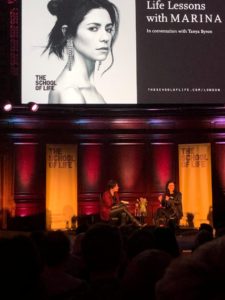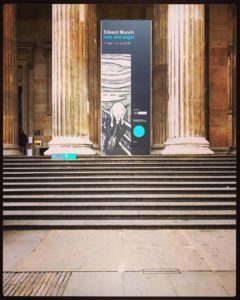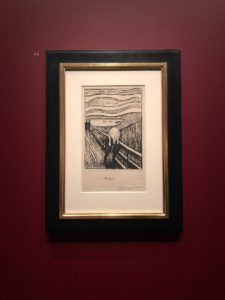LOVE + FEAR, Love and Angst, & Meaning of Life
A couple of weeks ago, I attended ‘Life Lessons with MARINA’, a conversation between two influential women: Marina Diamantis, a Greek-British singer-songwriter, and Professor Tanya Byron, a clinical psychologist and writer. The event was organized by The School Of Life, a global organization headquartered in London. It took place on the day that ‘LOVE’ (the first half of ‘LOVE + FEAR’, Marina’s fourth album) was released. The School Of Life offers a range of services, including classes, workshops, and events, such as the one I attended. They also offer therapy services and publish books and educational videos on YouTube. A common denominator of all these services is the focus on emotional intelligence and wellbeing.
Named after two basic emotions, ‘LOVE + FEAR’, Marina’s fourth studio album is due to be released in full on 26th April 2019. This concept album of two halves was inspired by Elisabeth Kübler-Ross, famous for her writings on dying, bereavement and the five stages of grief. According to the Swiss-American psychiatrist and writer, there are only two emotions: love and fear, and ‘all positive emotions come from love, all negative emotions from fear’.
All the things I’ve done and seen
Still, I don’t know what life means
All the people living in, living in the world today
We’re united by our love, we’re united by our pain
All the things that I’ve done and I’ve seen
Still, I don’t know, don’t know what it means
To be human
From Attachment Theory to Obsessions to Love + Fear
Naturally, Marina’s conversation with Byron largely focused on her songs and music, but also on emotions and psychology. Drawing from both her personal experiences and her studies in psychology, Marina discussed attachment theory, whilst reflecting on her personal journey, including her earlier life and family. Born to a Greek father and a Welsh mother, she talked about her childhood in rural Wales, as well as in Athens. Albeit not a victim of significant bullying or mental illness (although she experienced OCD symptoms inspiring her song ‘Obsessions’), she explored these difficult experiences affecting a large number of young people, including many among her fans and the event’s audience.
Marina also talked about social media and the Instagram culture and how the power of an image can negatively affect teenagers and young adults’ emotional wellbeing, including their self-worth and esteem. She reflected that we, human beings, are whole persons, of whom the image, the exterior, or the appearance, is only a tiny part, something that we often lose sight of, as we scroll down our Instagram feed.
Moving on to her adult life, she reflected on her relationships and discussed her earlier fear of rejection. She also talked about the identity crisis she experienced a few years ago, when she felt like she didn’t want to be an artist anymore. She explained how this identity crisis led her to change her name from Marina and the Diamonds to simply MARINA. It was this crisis that also propelled her to study Psychology (fuelled by the books she had been reading, such as the ‘End Of Your World’).

Meanwhile, Byron coined the phrase ‘fucked up and fabulous’, which struck a chord and resonated with both Marina and the audience. She re-defined our ‘fuckedupness’ as a strength rather than a weakness.
Love and Angst
A few days after the ‘Life Lessons with MARINA’ and the release of ‘LOVE’ (the first half of ‘LOVE + FEAR’), I visited an art exhibition at the British Museum in London. Already a fan of Edvard Munch, I wanted to learn more about the renowned Norwegian painter – his life as well as his art. Interestingly, the exhibition was named after two emotions: love and angst. In that sense, it reminded me of ‘LOVE + FEAR’. While Marina explores her emotions through music, Munch explored his through painting.

‘Edvard Munch: Love and Angst’ runs from 11 April to 21 July 2019, and features over sixty lithographs and woodcuts, including a lithograph based on his masterpiece ‘The Scream’. The titles of his works were telling: ‘Angst’, ‘Despair’, ‘The Sick Child’ (the only painting in the exhibition), ‘Death in the Sick Room’, ‘Vampire’ (originally called ‘Love and Pain’), ‘Jealousy II’, ‘Desire’, ‘The Kiss IV’. Inspired by a number of experiences, including the death of his mother and later of his sister Sophie (at the age of 15), his love affair with Milly Thaulow, his sister Laura’s mental illness (schizophrenia), and his own nervous breakdown (aggravated by anxiety and alcoholism), Munch beautifully depicted a range of emotions: from love and desire to jealousy, anxiety and grief.

A restless traveler, the Norwegian artist spent long periods in Paris and Berlin, where he got acquainted with intellectuals and artists. Indeed, ‘Love and Angst’ also features works from other painters that inspired Munch, such as the French Edgar Degas, Henri de Toulouse-Lautrec, Paul Gauguin (whom Munch never actually met) and Odilon Redon. The latter’s ‘Obsession’, displayed in the exhibition, further reminded me of Marina.
The Meaning of Life
Inspired by the first School of Life event I’ve attended, I read The Meaning of Life an ideal follow-up to ‘Man’s Search for Meaning’ that I’d recently read.
A beautifully written book published by the School of Life, ‘The Meaning of Life’ encouraged me to reflect on what constitutes a meaningful life. In the introduction, I read that a meaningful life is different from a happy life; a meaningful life aims at fulfillment rather than day-to-day contentment. The book then explores eight different sources of meaning: love, family, work, friendship, culture, politics, nature, and philosophy. The chapters about work and culture resonated with me the most. In the former, I read about creativity as an ingredient to meaningful work. But creativity is not just about something big like art or literature; it can also be about ‘(sometimes very small) ways of improving life’. In the chapter about culture, meaning is explored from different angles and perspectives: home, music, books, clothes, and travel.
Culture and the Meaning of Life
An idea I found particularly interesting was that music ‘offers amplification and encouragement’ to what lies beneath our conscious awareness; quite like psychotherapy, it can help us gain access to subconscious feelings and emotions that we are hardly attuned to. ‘We end up feeling the emotions that are our due.’
Books, on the other hand, simplify. This is in contrast to the complexity of life, including the complexity of our feelings. While in real life we often struggle to verbalize our emotions, a book can simplify a complex situation by focusing on what matters the most and subsequently render our feelings more visible and accessible. ‘The great writers show us where to look. They also help us to feel.’
Travel and the Meaning of Life
Then, there’s travel, which can be both therapeutic but also ‘the most meaningful agent of maturation’. An outer journey can help us with our inner one, an idea that quite surprisingly dates back to the Middle Ages and the religious pilgrimages. Things, of course, have now changed. When we have a toothache, we no longer travel to Rome to the Basilica of Saint Lorenzo to touch the bones of Saint Apollonia, the patron saint of teeth; we take a trip to the dentist instead. But we travel to relax (i.e. to a yoga retreat or to a beach holiday), to learn (i.e. to museums, historical or even religious sites), to feel, or for a combination of the above.
To follow my travels around the world, simply subscribe to the Traveling Psychiatrist (just click on the menu on the left-hand side).
Meanwhile, don’t forget to also follow Marina’s advice:
sit back and enjoy your problems
you don’t always have to solve them
’cause your worst days, they are over
So enjoy your life
yeah you might as well accept it
don’t you waste your time regretting
’cause your worst days, they are over
So enjoy your life!
Alex
(the Traveling Psychiatrist)
Further reading
If you enjoyed this post, check out my post about Vienna, music, Frankl and meaning.
If you’d like to read another book by the School of Life, or simply read about psychoanalysis or psychodynamic psychotherapy, I would recommend What is Psychotherapy?
Other books by the School of Life that I am interested in reading but I am yet to read are:
Also, on my list are:
Life Lessons: Two Experts on Death and Dying Teach Us about the Mysteries of Life and Living
The Power of Music: Pioneering Discoveries in the New Science of Song
If you’ve read them, please let me know what you think.
Further listening
A couple of weeks ago, Sarah Walker, Claudia Hammond, and saxophonist Faye MacCalman explored the topic of music and emotion. They discussed the effect of classical music on cognition (including the famous Mozart effect) but also on relaxation. Claudia explained that classical music can lower cortisol (the stress hormone), reduce anxiety, decrease negative thoughts, and slow heart rate, and can, therefore, help us relax. She also mentioned a recent study on the effect of music on sleep. Quite interestingly, participants mentioned both classical (Bach, Mozart and Chopin) and pop/rock music (Ed Sheeran and Coldplay) as helping them sleep. You can listen to these interesting discussions, as well as wonderful classical music (from Mozart to Steve Reich, and from Grieg to Poulenc) on the BBC Radio 3 website.
One Comment
oprolevorter
Great post. I am facing a couple of these problems.